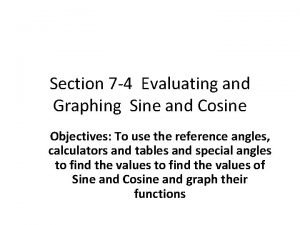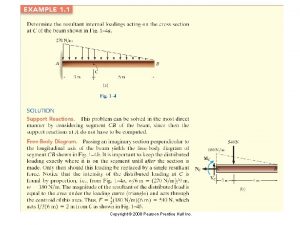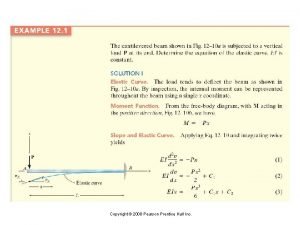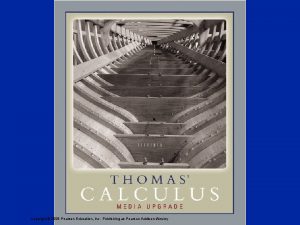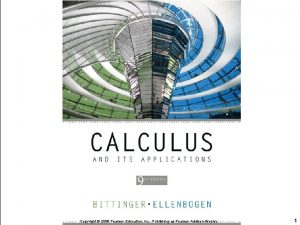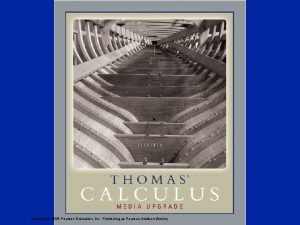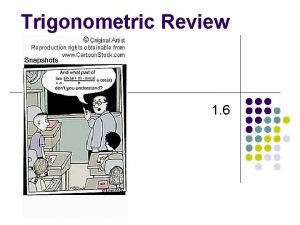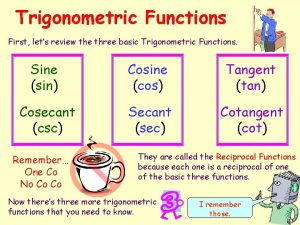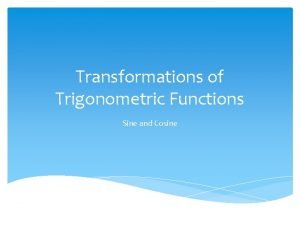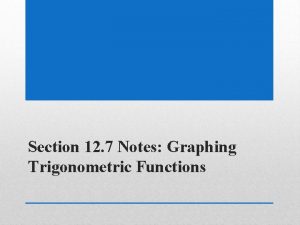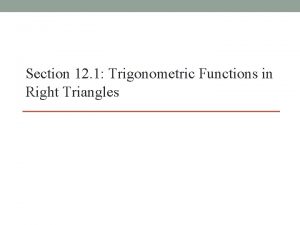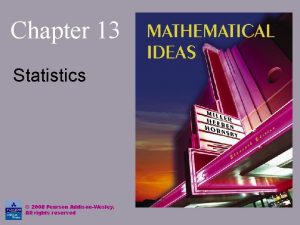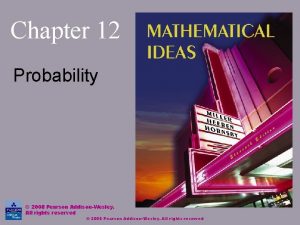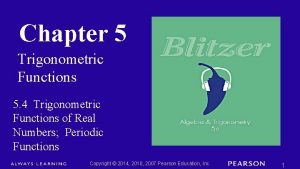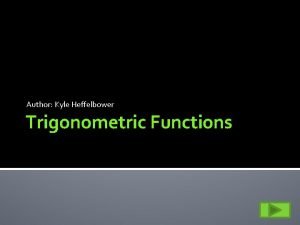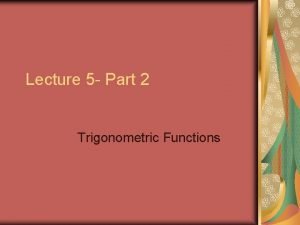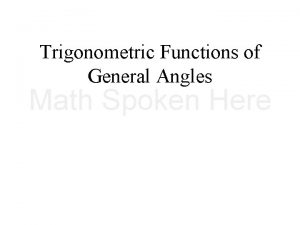1 Trigonometric Functions 2008 Pearson AddisonWesley All rights






































- Slides: 38

1 Trigonometric Functions © 2008 Pearson Addison-Wesley. All rights reserved

1 Trigonometric Functions 1. 1 Angles 1. 2 Angle Relationships and Similar Triangles 1. 3 Trigonometric Functions 1. 4 Using the Definitions of the Trigonometric Functions 2 Copyright © 2008 Pearson Addison-Wesley. All rights reserved.

1. 1 Angles Basic Terminology ▪ Degree Measure ▪ Standard Position ▪ Coterminal Angles 3 Copyright © 2008 Pearson Addison-Wesley. All rights reserved.

1. 1 Example 1 Finding the Complement and the Supplement of an Angle (page 3) For an angle measuring 55°, find the measure of its complement and its supplement. Complement: 90° − 55° = 35° Supplement: 180° − 55° = 125° 4 Copyright © 2008 Pearson Addison-Wesley. All rights reserved.

1. 1 Example 2(a) Finding Measures of Complementary and Supplementary Angles (page 3) Find the measure of each angle. The two angles form a right angle, so they are complements. The measures of the two angles are and 5 Copyright © 2008 Pearson Addison-Wesley. All rights reserved.

1. 1 Example 2(b) Finding Measures of Complementary and Supplementary Angles (page 3) Find the measure of each angle. The two angles form a straight angle, so they are supplements. The measures of the two angles are and 6 Copyright © 2008 Pearson Addison-Wesley. All rights reserved.

1. 1 Example 3 Calculating with Degrees, Minutes, and Seconds (page 4) Perform each calculation. (a) (b) 7 Copyright © 2008 Pearson Addison-Wesley. All rights reserved.

1. 1 Example 4 Converting Between Decimal Degrees and Degrees, Minutes, and Seconds (page 5) (a) Convert 105° 20′ 32″ to decimal degrees. (b) Convert 85. 263° to degrees, minutes, and seconds. 8 Copyright © 2008 Pearson Addison-Wesley. All rights reserved.

1. 1 Example 5 Finding Measures of Coterminal Angles (page 6) Find the angles of least possible positive measure coterminal with each angle. (a) 1106° Add or subtract 360° as many times as needed to obtain an angle with measure greater than 0° but less than 360°. An angle of 1106° is coterminal with an angle of 26°. (b) – 150° An angle of – 150° is coterminal with an angle of 210°. 9 Copyright © 2008 Pearson Addison-Wesley. All rights reserved.

1. 1 Example 5 Finding Measures of Coterminal Angles (cont. ) (c) – 603° An angle of – 603° is coterminal with an angle of 117°. 10 Copyright © 2008 Pearson Addison-Wesley. All rights reserved.

1. 1 Example 6 Analyzing the Revolutions of a CD Player (page 7) A wheel makes 270 revolutions per minute. Through how many degrees will a point on the edge of the wheel move in 5 sec? The wheel makes 270 revolutions in one minute or revolutions per second. In five seconds, the wheel makes revolutions. Each revolution is 360°, so a point on the edge of the wheel will move 11 Copyright © 2008 Pearson Addison-Wesley. All rights reserved.

1. 2 Angles Geometric Properties ▪ Triangles 12 Copyright © 2008 Pearson Addison-Wesley. All rights reserved.

1. 2 Example 1 Finding Angle Measures (page 12) Find the measures of angles 1, 2, 3, and 4 in the figure, given that lines m and n are parallel. Angles 2 and 3 are interior angles on the same side of the transversal, so they are supplements. 13 Copyright © 2008 Pearson Addison-Wesley. All rights reserved.

1. 2 Example 1 Finding Angle Measures (cont. ) Angles 1 and 2 have equal measure because they are vertical angles, and angles 1 and 4 have equal measure because they are alternate exterior angles. 14 Copyright © 2008 Pearson Addison-Wesley. All rights reserved.

1. 2 Example 2 Finding Angle Measures (page 12) The measures of two of the angles of a triangle are 33° and 26°. Find the measure of the third angle. The sum of the measures of the angles of a triangle is 360°. Let x = the measure of the third angle. The third angle measures 121°. 15 Copyright © 2008 Pearson Addison-Wesley. All rights reserved.

1. 2 Example 3 Finding Angle Measures in Similar Triangles (page 14) In the figure, triangles DEF and GHI are similar. Find the measures of angles G and I. The triangles are similar, so the corresponding angles have the same measure. 16 Copyright © 2008 Pearson Addison-Wesley. All rights reserved.

1. 2 Example 4 Finding Side Lengths in Similar Triangles (page 15) Given that triangle MNP and triangle QSR are similar, find the lengths of the unknown sides of triangle QSR. The triangles are similar, so the lengths of the corresponding sides are proportional. PM corresponds to RQ. PN corresponds to RS. MN corresponds to QS. Copyright © 2008 Pearson Addison-Wesley. All rights reserved. 17

1. 2 Example 4 Finding Side Lengths in Similar Triangles (cont. ) 18 Copyright © 2008 Pearson Addison-Wesley. All rights reserved.

1. 2 Example 5 Finding the Height of a Flagpole (page 15) Samir wants to know the height of a tree in a park near his home. The tree casts a 38 -ft shadow at the same time as Samir, who is 63 in. tall, casts a 42 -in. shadow. Find the height of the tree. Let x = the height of the tree The tree is 57 feet tall. Copyright © 2008 Pearson Addison-Wesley. All rights reserved. 19

1. 3 Trigonometric Functions ▪ Quadrantal Angles 20 Copyright © 2008 Pearson Addison-Wesley. All rights reserved.

1. 3 Example 1 Finding Function Values of an Angle (page 23) The terminal side of an angle θ in standard position passes through the point (12, 5). Find the values of the six trigonometric functions of angle θ. x = 12 and y = 5. 13 21 Copyright © 2008 Pearson Addison-Wesley. All rights reserved.

1. 3 Example 2 Finding Function Values of an Angle (page 23) The terminal side of an angle θ in standard position passes through the point (8, – 6). Find the values of the six trigonometric functions of angle θ. x = 8 and y = – 6. 10 6 22 Copyright © 2008 Pearson Addison-Wesley. All rights reserved.

1. 3 Example 2 Finding Function Values of an Angle (cont. ) 23 Copyright © 2008 Pearson Addison-Wesley. All rights reserved.

1. 3 Example 3 Finding Function Values of an Angle (page 25) Find the values of the six trigonometric functions of angle θ in standard position, if the terminal side of θ is defined by 3 x – 2 y = 0, x ≤ 0. Since x ≤ 0, the graph of the line 3 x – 2 y = 0 is shown to the left of the y-axis. Find a point on the line: Let x = – 2. Then A point on the line is (– 2, – 3). Copyright © 2008 Pearson Addison-Wesley. All rights reserved. 24

1. 3 Example 3 Finding Function Values of an Angle (cont. ) 25 Copyright © 2008 Pearson Addison-Wesley. All rights reserved.

1. 3 Example 4(a) Finding Function Values of Quadrantal Angles (page 26) Find the values of the six trigonometric functions of a 360° angle. The terminal side passes through (2, 0). So x = 2 and y = 0 and r = 2. 26 Copyright © 2008 Pearson Addison-Wesley. All rights reserved.

1. 3 Example 4(b) Finding Function Values of Quadrantal Angles (page 26) Find the values of the six trigonometric functions of an angle θ in standard position with terminal side through (0, – 5). x = 0 and y = – 5 and r = 5. 27 Copyright © 2008 Pearson Addison-Wesley. All rights reserved.

1. 4 Using the Definitions of the Trigonometric Functions Reciprocal Identities ▪ Signs and Ranges of Function Values ▪ Pythagorean Identities ▪ Quotient Identities 28 Copyright © 2008 Pearson Addison-Wesley. All rights reserved.

1. 4 Example 1 Using the Reciprocal Identities (page 31) Find each function value. (a) tan θ, given that cot θ = 4. tan θ is the reciprocal of cot θ. (b) sec θ, given that sec θ is the reciprocal of cos θ. 29 Copyright © 2008 Pearson Addison-Wesley. All rights reserved.

1. 4 Example 2 Finding Function Values of an Angle (page 32) Determine the signs of the trigonometric functions of an angle in standard position with the given measure. (a) 54° (b) 260° (c) – 60° (a) A 54º angle in standard position lies in quadrant I, so all its trigonometric functions are positive. (b) A 260º angle in standard position lies in quadrant III, so its sine, cosine, secant, and cosecant are negative, while its tangent and cotangent are positive. (c) A – 60º angle in standard position lies in quadrant IV, so cosine and secant are positive, while its sine, cosecant, tangent, and cotangent are negative. 30 Copyright © 2008 Pearson Addison-Wesley. All rights reserved.

1. 4 Example 3 Identifying the Quadrant of an Angle (page 33) Identify the quadrant (or possible quadrants) of an angle θ that satisfies the given conditions. (a) tan θ > 0, csc θ < 0 tan θ > 0 in quadrants I and III, while csc θ < 0 in quadrants III and IV. Both conditions are met only in quadrant III. (b) sin θ > 0, csc θ > 0 sin θ > 0 in quadrants I and II, as is csc θ. Both conditions are met in quadrants I and II. 31 Copyright © 2008 Pearson Addison-Wesley. All rights reserved.

1. 4 Example 4 Deciding Whether a Value is in the Range of a Trigonometric Function (page 33) Decide whether each statement is possible or impossible. (a) cot θ = –. 999 (b) cos θ = – 1. 7 (c) csc θ = 0 (a) cot θ = –. 999 is possible because the range of cot θ is (b) cos θ = – 1. 7 is impossible because the range of cos θ is [– 1, 1]. (c) csc θ = 0 is impossible because the range of csc θ is 32 Copyright © 2008 Pearson Addison-Wesley. All rights reserved.

1. 4 Example 5 Finding All Function Values Given One Value and the Quadrant (page 33) Angle θ lies in quadrant III, and Find the values of the other five trigonometric functions. Since and y = – 8. and θ lies in quadrant III, then x = – 5 33 Copyright © 2008 Pearson Addison-Wesley. All rights reserved.

1. 4 Example 5 Finding All Function Values Given One Value and the Quadrant (cont. ) 34 Copyright © 2008 Pearson Addison-Wesley. All rights reserved.

1. 4 Example 6 Finding Other Function Values Given One Value and the Quadrant (page 35) Find cos θ and tan θ given that sin θ cos θ > 0. and Reject the negative root. 35 Copyright © 2008 Pearson Addison-Wesley. All rights reserved.

1. 4 Example 6 Finding Other Function Values Given One Value and the Quadrant (cont. ) 36 Copyright © 2008 Pearson Addison-Wesley. All rights reserved.

1. 4 Example 7 Finding Other Function Values Given One Value and the Quadrant (page 36) Find cot θ and csc θ given that cos θ θ is in quadrant II. and Since θ is in quadrant II, cot θ < 0 and csc θ > 0. Reject the negative root: Copyright © 2008 Pearson Addison-Wesley. All rights reserved. 37

1. 4 Example 7 Finding Other Function Values Given One Value and the Quadrant (cont. ) 38 Copyright © 2008 Pearson Addison-Wesley. All rights reserved.
 2012 pearson education inc
2012 pearson education inc Pearson education inc. all rights reserved
Pearson education inc. all rights reserved Pearson education inc. all rights reserved
Pearson education inc. all rights reserved Copyright 2010 pearson education inc
Copyright 2010 pearson education inc Pearson education inc. all rights reserved
Pearson education inc. all rights reserved Trigonometric graph equation
Trigonometric graph equation Arccos trig
Arccos trig 2008 2008
2008 2008 Pearson education limited 2008
Pearson education limited 2008 Pearson education inc publishing as pearson prentice hall
Pearson education inc publishing as pearson prentice hall Prentice hall inc
Prentice hall inc 2008 pearson prentice hall inc
2008 pearson prentice hall inc 2008 pearson education inc
2008 pearson education inc 2008 pearson education inc
2008 pearson education inc 2008 pearson education inc
2008 pearson education inc Pearson education limited 2008
Pearson education limited 2008 Pearson education limited 2008
Pearson education limited 2008 Master budget example
Master budget example Pearson education 2008
Pearson education 2008 2008 pearson education inc
2008 pearson education inc 2008 pearson education inc
2008 pearson education inc 2008 pearson education inc
2008 pearson education inc 2008
2008 Pearson education limited 2015
Pearson education limited 2015 Negative rights vs positive rights
Negative rights vs positive rights Riparian rights vs littoral rights
Riparian rights vs littoral rights Moral duties
Moral duties Legal rights and moral rights
Legal rights and moral rights Negative rights
Negative rights Positive vs negative rights
Positive vs negative rights Positive rights vs negative rights
Positive rights vs negative rights Positive rights and negative rights
Positive rights and negative rights Name all the lines
Name all the lines Cofunction identities
Cofunction identities Three basic trigonometric functions
Three basic trigonometric functions Trig function transformations
Trig function transformations How to find period in sine function
How to find period in sine function 12-7 graphing trigonometric functions answers
12-7 graphing trigonometric functions answers 12-1 trigonometric functions in right triangles
12-1 trigonometric functions in right triangles





